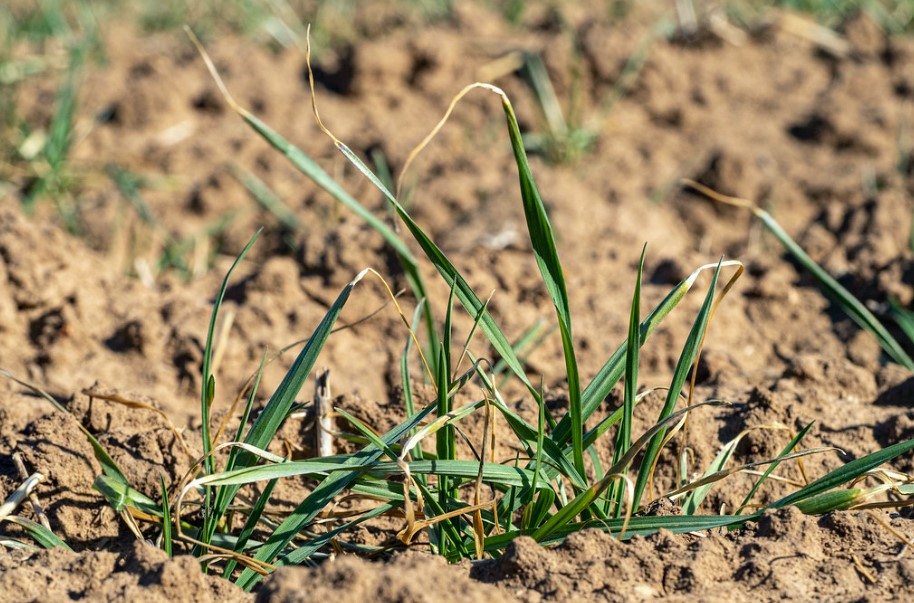Thu, 22 Sep 2022 16:05:20 CDT
The National Cattlemen’s Beef Association (NCBA) released the following statement in response to a Notice to Trade published today by the U.S. Department of Agriculture’s (USDA) Agricultural Mark…

Sep 22
Thu, 22 Sep 2022 16:05:20 CDT
The National Cattlemen’s Beef Association (NCBA) released the following statement in response to a Notice to Trade published today by the U.S. Department of Agriculture’s (USDA) Agricultural Mark…
Sep 22
Thu, 22 Sep 2022 15:19:15 CDT
The U.S. Department of Agriculture and the Oklahoma Department of Agriculture are now putting the Daily Cash Grain Report into a PDF format – we are saving that PDF and archiving them for today’s specific report. To see today’s update, click on the PDF report link at the bottom of this story.
In addition to the PDF of the daily report, you can also listen to the Cash Grain Report by calling 405-621-5533. Push 2 for the grain report.
Sep 22
Thu, 22 Sep 2022 14:26:38 CDT

Listen to today’s report with Justin Lewis, by clicking or tapping on the LISTEN bar
Sep 22
Thu, 22 Sep 2022 13:08:12 CDT
Click here to listen to audio
At the National Farmers Union Legislative Fly-In this past week in Washington, DC, Radio Oklahoma Ag Network intern, Cheyenne Leach, had the chance to visit with the CEO of…
Sep 22
Thu, 22 Sep 2022 12:10:30 CDT

By Gail Ellis
The effects of drought are devastating, but agricultural data collected during such challenging times is a valuable teaching tool.
Oklahoma State University Extension specialists have some retrospective on the historic drought that swept through the plains a decade ago and are learning how it can benefit producers in today’s similar climate.
Cattle and livestock
OSU Extension livestock marketing specialist Derrell Peel offered the following takeaways on drought response:
• Abusing pastures, especially native range, slows recovery when the drought is over and may impact productivity for years.
• Pasture and grazing management is even more critical during drought, not only to maintain forage resources, but also to avoid problems with prussic acid, nitrates and toxic plant consumption by cattle.
• Keeping more cows than ranchers can reasonably manage leads to delayed losses in reproductive performance and extends drought costs beyond the dry years.
• Bringing in hay from multiple locations can lead to weed issues in pastures.
• When cattle numbers decline, the market will respond with dramatic and volatile price signals that prompt producer action.
• The 2011-2014 drought resulted in record high breeding animal and feeder cattle prices followed by a dramatic price crash.
Dave Lalman, OSU Extension beef cattle specialist, said even though cattle numbers dropped significantly in Oklahoma and Texas during the last drought, liquidation improved the overall quality of the national cow herd.
“The drought led to aggressive culling, resulting in more rapid progress in some traits, such as temperament, udder structure and productivity,” Lalman said.
“At the same time, severe drought conditions stimulated widespread interest in creating a cow herd that is a better match to local ranch conditions.”
Those conditions, in terms of precipitation, have been well above average since about 1983. From the consumer perspective, cattle are a lot better than they were 30 years ago.
“The industry had successfully selected for cattle with increased growth, carcass weight and marbling, but it wasn’t as focused on matching cattle to their forage resources. The 2011 drought changed all that,” he said.
Keeping cows that can adapt to their environment, particularly a dry climate, is important in tough years, Lalman said. Other takeaways from the last severe drought period include:
• For a commercial cow/calf operation, purchasing seedstock that excel in fertility and fleshing ability without requiring a lot of expensive supplemental feed is critical.
“I don’t care how much genetic potential their calves have for growth, carcass yield or marbling, if a cow doesn’t raise a calf, you don’t have a carcass to sell,” Lalman said.
• A cow herd developed with the fundamental principles of moderate mature size, moderate genetic potential for milk production, good fleshing ability on grass and good feet has a much higher probability of thriving in tough environments and through drought periods.
• Reduce the stocking rate and work to develop a grazing system less reliant on purchased or harvested hay. In 1980, Oklahoma produced about three-fourths ton of hay for every beef cow. Today, the state produces two-and-a-half tons of hay for every beef cow. The system exposes cow/calf producers to more risk and forces excessive destocking when it doesn’t rain.
“I think 2011 and 2012 made an impression that will last,” Lalman said. “A lot of serious producers took note and are better prepared today with cows that are a better match to their environment, improved grazing systems, a lower stocking rate and an emergency fund of good quality hay stored in a barn. There’s just a lot more people taking precautions.”
Wheat varieties
Brett Carver, OSU regents professor and wheat genetics chair, said it’s a survival of the fittest as he and the OSU Wheat Improvement Team sift through thousands of wheat genetic lines every year to develop new varieties. OSU research showed the germplasm Showdown stood out during its formative years when drought was a major factor.
“From 2011 to 2014, Showdown as an experimental line was drought resistant by nature, and those genetics are fixed. They don’t change,” he said. “Showdown packs a punch against drought.”
While Showdown shows potential as a drought-friendly wheat variety, Carver said wheat breeding involves studying varieties that can withstand a range of intense weather patterns, including the wetter years in which disease epidemics can be equally devastating as chronic drought stress.
“There’s no model genotype for what we’ll need 10 years from now,” he said. “We give a variety five years of testing once it’s been identified and look for maturity and adaptation patterns that fit both extremes.”
OSU Extension uses research-based information to help all Oklahomans solve local issues and concerns, promote leadership and manage resources wisely throughout the state’s 77 counties. Most information is available at little to no cost.
Sep 22
Thu, 22 Sep 2022 11:04:08 CDT
Today, the National Cattlemen’s Beef Association (NCBA) urged the Senate Committee on Agriculture, Nutrition, and Forestry to confirm key nominees for Under Secretary for Food Safety and Under Secretar…
Sep 22
Thu, 22 Sep 2022 10:58:08 CDT
Senior Farm and Ranch Broadcaster, Ron Hays, is featuring comments from Oklahoma Cattlemen’s Association Vice President, Michael Kelsey at the Emergency Drought Commission’s first meeting, talki…
Sep 22
Thu, 22 Sep 2022 10:43:19 CDT
Yesterday, Congressman Frank Lucas (OK-03) joined House Committee on Financial Services Republicans sending a letter to Amalgamated Bank, objecting to the bank’s efforts to force companies to track law…
Sep 22
Thu, 22 Sep 2022 10:40:01 CDT
By: Amanda de Oliveira Silva, Small Grains Extension Specialist
With severe dry conditions and high temperatures in our state, it is good to consider the possible effects of high temperature and drought…
Sep 22
Thu, 22 Sep 2022 10:09:09 CDT

Rep. Logan Phillips, R-Mounds, on Thursday praised the Oklahoma House and Senate Joint Committee on Pandemic Relief Funding for their focus on addressing broadband issues through projects they advanced. The projects advanced during the joint committee’s meeting on Tuesday will now be considered when the Legislature reconvenes it’s special session to appropriate American Rescue Plan Act (ARPA) dollars.
“We have not seen this type of investment in Oklahoma since the 1920’s when we initially built out electricity to rural areas,” Phillips said. “This is a once of a lifetime opportunity that will make Oklahoma a centerpiece for the next ‘Industrial Revolution.’ I have been a champion for broadband issues throughout my time in the Legislature, and I’m proud to see all of that hard work paying off as we invest these ARPA funds in broadband infrastructure and create a brighter future for our state.”
Broadband projects approved by the joint committee, both Tuesday and previously, include:
· Broadband Office Projects – $382.1 million to add to the capital funds amount to grant funds out for buildout of broadband infrastructure.
· Broadband Office Administration – $500,000 for administrative costs to support the establishment of the office.
· Broadband Mapping – $2 million to finish out the map that the Department of Commerce has been building over the last several years.
· Career Tech Broadband – $5 million for career techs to add classes that train a broadband workforce.
· OSU-IT – $365,068 for a training program at OSUIT to help with broadband workforce training.
“Improving broadband access, especially in rural areas, is essential for progress in our modern world,” said Sen. Lonnie Paxton, R-Tuttle, Co-Chair of the Transportation, Infrastructure & Rural Development Working Group. “From improving our kids’ education to healthcare outcomes and even agriculture, broadband touches every aspect of life. This historic investment will ensure the framework is funded and address any barriers we may face in deploying this project.”
These funds are in addition to $167 million from the Capital Projects Fund that will be going to broadband related expenses. Phillips, who also served as Co-Chair of the Transportation, Infrastructure & Rural Development Working Group said the goal is to provide 95% of all Oklahomans with access to broadband within the next 5 years.
In total, the committee’s approvals, combined with previously approved projects, resulted in recommendation of over 60 projects totaling nearly all of Oklahoma state government’s $1.87 billion share of ARPA funding.
Program areas and specific projects approved by the joint committee will now be placed into appropriations bills for consideration when the Legislature reconvenes the Second Extraordinary Session of the 58th Oklahoma Legislature, which was called for the purpose of evaluating ARPA projects advanced by the joint committee and matters of statewide economic development.